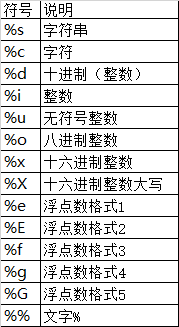1 %用法
1.1整数的输出
%o —— oct 八进制
%d —— dec 十进制
%x —— hex 十六进制
print('%o' % 20) #24
print('%d' % 20) #20
print('%x' % 20) #14
1.2浮点数输出
%f ——默认保留小数点后面六位有效数字
%.3f,保留3位小数位
%e ——默认保留小数点后面六位有效数字,指数形式输出
%.3e,保留3位小数位,使用科学计数法
%g ——在保证六位有效数字的前提下,使用小数方式,否则使用科学计数法
%.3g,保留3位有效数字,使用小数或科学计数法
1.3round四舍五入
round(number[, ndigits])
参数:
number - 这是一个数字表达式。
ndigits - 表示从小数点到最后四舍五入的位数。默认值为0。
返回值
该方法返回x的小数点舍入为n位数后的值。
print(round(1.1125)) #1
print(round(1.1135,3)) #1.113
print(round(1.1125,3)) #1.113
1.4字符串输出
%s
%10s——右对齐,占位符10位
%-10s——左对齐,占位符10位
%.2s——截取2位字符串
%10.2s——10位占位符,截取两位字符串
print('%s' % 'hello world')
print('%s' % 1)
print('%20s' % 'hello world')
print('%-20s' % 'hello world')
print('%.2s' % 'hello world')
print('%10.2s' % 'hello world')
print('%-10.2s' % 'hello world')
输出结果:
print(’%s’ % ‘hello world’)
print(’%s’ % 1)
print(’%20s’ % ‘hello world’)
print(’%-20s’ % ‘hello world’)
print(’%.2s’ % ‘hello world’)
print(’%10.2s’ % ‘hello world’)
print(’%-10.2s’ % ‘hello world’)
常见格式:

常见转义字符:

2 format用法
format()功能更强大,该函数把字符串当成一个模板,通过传入的参数进行格式化,并且使用大括号‘{}’作为特殊字符代替‘%’
2.1位置匹配
(1)不带编号,即“{}”
(2)带数字编号,可调换顺序,即“{1}”、“{2}”
(3)带关键字,即“{a}”、“{tom}”
print('{} {}'.format('hello','world'))
print('{0} {1}'.format('hello', 'world'))
print('{0} {1} {0}'.format('hello','world'))
print('{1} {1} {0}'.format('hello','world'))
print('{a} {tom} {a}'.format(tom='hello',a='world'))
输出结果
hello world
hello world
hello world hello
world world hello
world hello world
print( '{0}, {1}, {2}'.format('a', 'b', 'c'))
print('{}, {}, {}'.format('a', 'b', 'c'))
print( '{2}, {1}, {0}'.format('a', 'b', 'c'))
print('{2}, {1}, {0}'.format(*'abc')) # 可打乱顺序
print('{0}{1}{0}'.format('abra', 'cad')) # 可重复
输出结果:
a, b, c
a, b, c
c, b, a
c, b, a
abracadabra
import datetime
d=datetime.datetime(2010,7,4,12,15,34)
print('{:%Y-%m-%d %H:%M:%S}'.format(d))
输出结果:
2010-07-04 12:15:34
2.2左中右对齐及位数补全
(1)< (默认)左对齐、> 右对齐、^ 中间对齐、= (只用于数字)在小数点后进行补齐
(2)取位数“{:4s}”、"{:.2f}"等
points=19
total=22
print('Correct answers: {:.2%}'.format(points/total))
print('{} is {:.2f}'.format(1.123,1.123))
print('{0} is {0:>10.2f}'.format(1.123))
print('{:+f}; {:+f}'.format(3.14, -3.14)) # 总是显示符号
print('{:,}'.format(1234567890))
输出结果:
Correct answers: 86.36%
1.123 is 1.12
1.123 is 1.12
+3.140000; -3.140000
1,234,567,890



; System.out.println(++i);的区别)
模块的方法)
)


)










